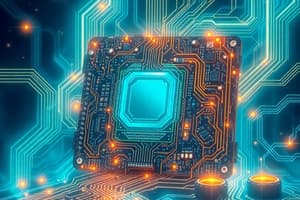Podcast
Questions and Answers
What is an Embedded System?
What is an Embedded System?
A combination of computer software and hardware which is either fixed in capability or programmable.
What could be possible reasons for the sudden interest in Embedded Systems?
What could be possible reasons for the sudden interest in Embedded Systems?
- Processors have shrunk in size (correct)
- Cost of processors has gone up
- Greater awareness of programmable processors (correct)
- Power consumption has increased
Give an example of an Embedded System.
Give an example of an Embedded System.
A fire alarm, or a laser printer.
Embedded Systems can only be independent systems.
Embedded Systems can only be independent systems.
Which of the following is a function performed by Microcomputers in washing machines?
Which of the following is a function performed by Microcomputers in washing machines?
Match the following applications with their functions:
Match the following applications with their functions:
The _______ is an example of an Embedded System that manages various aspects of printing.
The _______ is an example of an Embedded System that manages various aspects of printing.
Flashcards are hidden until you start studying
Study Notes
What is a System?
- A system is an arrangement of components that work together following specific rules.
- Systems are used to organize, perform, and complete tasks based on a fixed plan.
What is an Embedded System?
- An embedded system is a combination of software and hardware, designed to perform specific functions.
- Embedded systems can operate independently or as part of a larger system, with a focus on dedicated tasks within that system.
Why is there a growing interest in embedded systems?
- Technological advancements:
- Shrinking processor size with improved performance.
- Reduced power consumption.
- Lower cost of processors.
- Increased awareness that programmable processors offer advantages over purely hardwired systems:
- More robust designs.
- Shorter design cycles.
- Improved development environments:
- Prototyping options.
- Simulation and emulation for quicker design cycles.
- Other factors contributing to the rising interest:
- Increased use of microcontrollers in modern vehicles like cars.
- Development of adaptable runtime platforms like Java, allowing for a wider range of applications.
- Creation of integrated software environments for easier app development.
- Integration of embedded systems with the internet, enabling communication and networking of embedded systems across vast networks.
Applications of Embedded Systems:
- Embedded systems are found in many everyday devices, demonstrating their wide-reaching influence.
- Common Examples:
- Wristwatches
- Washing machines
- Microwave ovens
- Elevators
- Mobile telephones
- Printers
- Fax machines
- Telephone exchanges
- Automobiles
- Aircrafts
- Specific examples:
- Laser printers utilize embedded systems to manage aspects like user inputs, communication, error handling, and paper sensing.
Examples of Microcomputer Applications:
- Consumer Applications:
- Washing machine: controls water and spin cycles, accepts user inputs.
- Remote controls: Processes user input and sends commands to the device using infrared (IR) pulses.
- Exercise equipment: Tracks speed, distance, calories, heart rate, and logs workouts.
- Clocks and watches: Maintain time, set alarms, and display information.
- Games and toys: Entertain users with features like joystick input and video output.
- Audio/video equipment: Interacts with users and enhances performance.
- Communication Applications:
- Telephone answering machines: Store, organize, and replay messages.
- Telephone systems: Handle interactive switching and information retrieval.
- Cellular phones and pagers: Integrate keypads, inputs, sound output, and communication with central systems.
- ATM machines: Combines security measures with banking convenience.
- Automotive Applications:
- Automatic braking systems: Optimize stopping on slippery roads.
- Noise Cancellation systems: Improve audio quality by reducing background noise.
- Theft Deterrent devices: Offer keyless entry and alarm systems.
- Electronic ignition: Controls spark timing and fuel injection.
- Power windows and seats: Remember settings for different drivers.
- Instrumentation systems: Gather and present essential driver information.
- Military Applications:
- Smart weapons: Recognize friendly targets.
- Missile guidance systems: Guide missiles accurately to their targets.
- Global positioning systems (GPS): Determine a user's location on Earth.
- Industrial Applications:
- Setback thermostats: Adjust heating/cooling settings based on time of day to conserve energy.
- Traffic control systems: Monitor car positions and regulate traffic signals.
- Robot systems: Process sensor input to control robotic motions and actions.
Studying That Suits You
Use AI to generate personalized quizzes and flashcards to suit your learning preferences.




